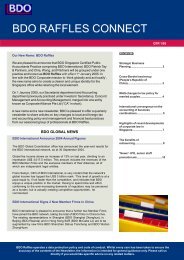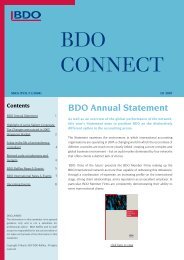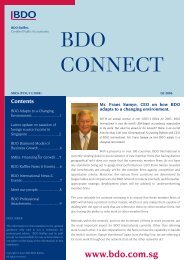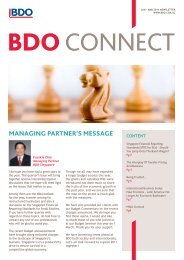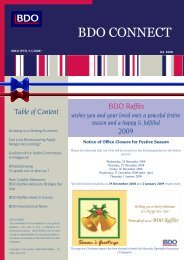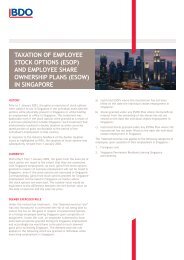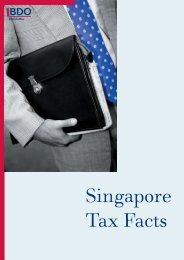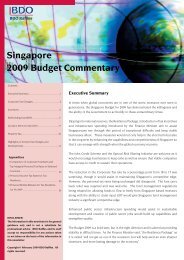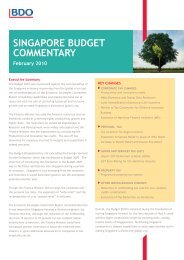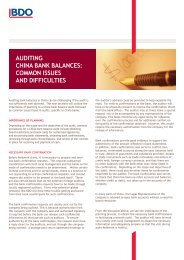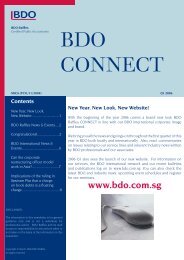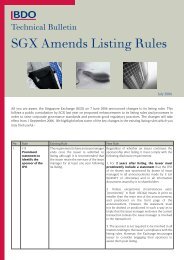Illustrative Financial Statements 2011 - bdo singapore
Illustrative Financial Statements 2011 - bdo singapore
Illustrative Financial Statements 2011 - bdo singapore
You also want an ePaper? Increase the reach of your titles
YUMPU automatically turns print PDFs into web optimized ePapers that Google loves.
ABC SINGAPORE LIMITED AND ITS SUBSIDIARIES<br />
NOTES TO THE FINANCIAL STATEMENTS<br />
FOR THE FINANCIAL YEAR ENDED 31 DECEMBER <strong>2011</strong> (Continued)<br />
FRS 1: 112, 117<br />
2. Summary of significant accounting policies (Continued)<br />
2.15 Joint venture (Continued)<br />
Commentary<br />
FRS 31: 38<br />
Jointly-controlled entities may also be consistently accounted for using the equity method and<br />
when so, the policy described in Note 2.14 can be considered.<br />
2.16 Impairment of tangible and intangible assets excluding goodwill<br />
FRS 36: 9<br />
FRS 36: 22<br />
FRS 36: 24<br />
FRS 36: 6<br />
FRS 36: 30, 31<br />
FRS 36: 59<br />
FRS 36: 60<br />
FRS 36: 114<br />
FSR 36: 117<br />
FRS 36: 119<br />
At the end of each financial year, the Group reviews the carrying amounts of its tangible<br />
and intangible assets to determine whether there is any indication that those assets have<br />
suffered an impairment loss. If any such indication exists, the recoverable amount of the<br />
asset is estimated in order to determine the extent of the impairment loss (if any). Where<br />
it is not possible to estimate the recoverable amount of an individual asset, the Group<br />
estimates the recoverable amount of the cash-generating unit to which the asset belongs.<br />
Intangible assets with indefinite useful lives and intangible assets not yet available for use<br />
are tested for impairment annually, and whenever there is an indication that the asset<br />
may be impaired.<br />
The recoverable amount of an asset or cash-generating unit is the higher of its fair value<br />
less costs to sell and its value in use. In assessing value in use, the estimated future cash<br />
flows are discounted to their present value using a pre-tax discount rate that reflects<br />
current market assessments of the time value of money and the risks specific to the asset.<br />
If the recoverable amount of an asset (or cash-generating unit) is estimated to be less than<br />
its carrying amount, the carrying amount of the asset (cash-generating unit) is reduced to<br />
its recoverable amount. An impairment loss is recognised immediately in profit or loss,<br />
unless the relevant asset is carried at a revalued amount, in which case the impairment<br />
loss is treated as a revaluation decrease.<br />
Where an impairment loss subsequently reverses, the carrying amount of the asset<br />
(cash-generating unit) is increased to the revised estimate of its recoverable amount, but<br />
so that the increased carrying amount does not exceed the carrying amount that would<br />
have been determined had no impairment loss been recognised for the asset<br />
(cash-generating unit) in prior years. A reversal of an impairment loss is recognised<br />
immediately in profit or loss, unless the relevant asset is carried at a revalued amount, in<br />
which case the reversal of the impairment loss is treated as a revaluation increase.<br />
2.17 <strong>Financial</strong> instruments<br />
FRS 39: 14<br />
<strong>Financial</strong> assets and financial liabilities are recognised on the Group’s consolidated<br />
statement of financial position when the Group becomes a party to the contractual<br />
provisions of the instrument.<br />
Effective interest method<br />
FRS 39: 9<br />
The effective interest method is a method of calculating the amortised cost of a financial<br />
instrument and allocating the interest income or expense over the relevant period. The<br />
effective interest rate exactly discounts estimated future cash receipts or payments<br />
(including all fees on points paid or received that form an integral part of the effective<br />
interest rate, transaction costs and other premiums or discounts) through the expected<br />
life of the financial instrument, or where appropriate, a shorter period, to the net<br />
carrying amount of the financial instrument. Income and expense are recognised on an<br />
effective interest basis for debt instruments other than those financial instruments at fair<br />
value through profit or loss.<br />
44 | P a g e



